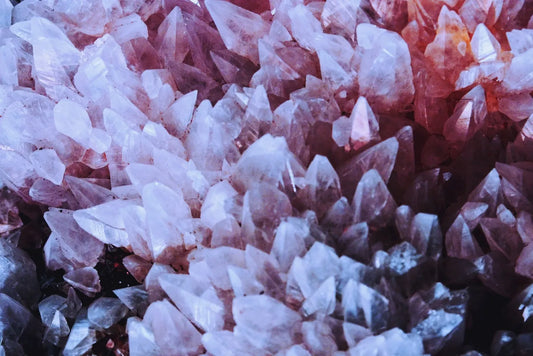
Feeling Blue? Heal Your Skin and Body with Chromotherapy
Matthew Rife
Since ancient times, color therapy, also known as chromotherapy, has been utilized for its healing properties. Color therapists contend that color can enter the body through the skin or the eyes. There are two main methods of color therapy, visual and reflective. With visual color therapy, an individual gazes at a given color, sometimes wearing colored lenses. For reflective color therapy, specific color light is emitted onto different regions of the body.
Every color we can perceive has a certain wavelength and frequency. Each individual frequency has a unique effect on each person and serves various functions. Typically, warm colors are used for energizing effects while cold colors are used for relaxing ones. Turquoise is one hue that has grown in favor recently as, according to some practitioners, it has strong curative qualities. Because of its inborn blue and green colors, turquoise also functions as a natural antibacterial and disinfectant. Moreover, it can result in positive improvements in diseases, nutrient absorption, and bodily repair.
Turquoise is a brilliant combination of green and blue, and it is thought to stimulate relaxation in the body and mind. Some healers believe that turquoise is highly beneficial to people who suffer from hyperactivity disorders, as it lowers functional brain activities. In addition to the mind, turquoise is thought to provide many physical healing effects including neutralizing acidity (disease) in the body and promoting alkalinity (healing).
When combined with other hues, turquoise can be especially beneficial for treating skin conditions, especially burns. Generally, in color therapy, there are two types of disorders: moist weeping and dry scaly. Chromotherapists treat these disorders in stages, starting with applying green. For moist weeping conditions, turquoise is applied until the skin begins to rebuild. For dry scaly conditions, practitioners apply green and yellow until the scaly skin sheds and a new layer of skin starts to appear. In persistent or severe cases, practitioners may use more yellow or orange followed by blue or indigo to produce total rebuilding. Turquoise can also be utilized cosmetically. A single application of turquoise has anti-aging properties, such as helping to tighten the skin and prevent sagging that occurs during the aging process.
Although some people firmly believe in the therapeutic benefits of chromotherapy, it is important to always consult with a healthcare professional before trying any new treatment or therapy.
References:
1. Sood, S., Gupta, S. K., & Mahajan, V. K. (2016). Role of colour therapy in management of post-burn scars. Indian journal of plastic surgery: official publication of the Association of Plastic Surgeons of India, 49(2), 278–283. https://doi.org/10.4103/0970-0358.183626
2. Qadir, M. I., & Ali, M. (2019). Color Therapy: A Complementary Therapy. Cureus, 11(11), e6217. https://doi.org/10.7759/cureus.6217
3. Gediya, S. K., Patel, U. K., & Patel, M. N. (2016). A Comprehensive Review on Herbal Drugs as Cosmeceuticals. Pharmacognosy reviews, 10(20), 99–105. https://doi.org/10.4103/0973-7847.194044
Every color we can perceive has a certain wavelength and frequency. Each individual frequency has a unique effect on each person and serves various functions. Typically, warm colors are used for energizing effects while cold colors are used for relaxing ones. Turquoise is one hue that has grown in favor recently as, according to some practitioners, it has strong curative qualities. Because of its inborn blue and green colors, turquoise also functions as a natural antibacterial and disinfectant. Moreover, it can result in positive improvements in diseases, nutrient absorption, and bodily repair.
Turquoise is a brilliant combination of green and blue, and it is thought to stimulate relaxation in the body and mind. Some healers believe that turquoise is highly beneficial to people who suffer from hyperactivity disorders, as it lowers functional brain activities. In addition to the mind, turquoise is thought to provide many physical healing effects including neutralizing acidity (disease) in the body and promoting alkalinity (healing).
When combined with other hues, turquoise can be especially beneficial for treating skin conditions, especially burns. Generally, in color therapy, there are two types of disorders: moist weeping and dry scaly. Chromotherapists treat these disorders in stages, starting with applying green. For moist weeping conditions, turquoise is applied until the skin begins to rebuild. For dry scaly conditions, practitioners apply green and yellow until the scaly skin sheds and a new layer of skin starts to appear. In persistent or severe cases, practitioners may use more yellow or orange followed by blue or indigo to produce total rebuilding. Turquoise can also be utilized cosmetically. A single application of turquoise has anti-aging properties, such as helping to tighten the skin and prevent sagging that occurs during the aging process.
Although some people firmly believe in the therapeutic benefits of chromotherapy, it is important to always consult with a healthcare professional before trying any new treatment or therapy.
References:
1. Sood, S., Gupta, S. K., & Mahajan, V. K. (2016). Role of colour therapy in management of post-burn scars. Indian journal of plastic surgery: official publication of the Association of Plastic Surgeons of India, 49(2), 278–283. https://doi.org/10.4103/0970-0358.183626
2. Qadir, M. I., & Ali, M. (2019). Color Therapy: A Complementary Therapy. Cureus, 11(11), e6217. https://doi.org/10.7759/cureus.6217
3. Gediya, S. K., Patel, U. K., & Patel, M. N. (2016). A Comprehensive Review on Herbal Drugs as Cosmeceuticals. Pharmacognosy reviews, 10(20), 99–105. https://doi.org/10.4103/0973-7847.194044



